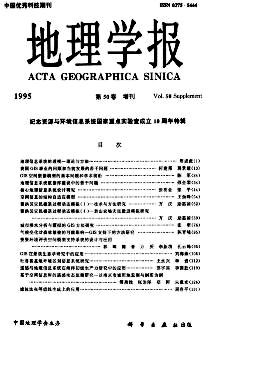Zhao Huanting, Wen Xiaosheng, Sun Zongxun, Zheng Deyan, Yuan Jiayi
The sea bottom landforms of Nansha Islands (Fig. 1) have three steps, descending from south to north. The first one is southern continental shelf(Sunda)of South China Sea and its depth is less than 150m, the second one is Nansha step(sea plateau) and its depth is 1 500─2 500m, the third step is central abyssal plain of South China Sea and its depth is about 4 000m (Fig. 2). There are upper and lower continental slopes among these three steps. Drowned valleys exist on continental shelf. Nansha step develops a crisscross network of troughs, the coral reefs which tower over sea plateau and the sea bottom reliefs contrast greatly. The bottom deposits are terrigenous silt and sand, organic detritus, coral reef, organic hemi-deep sea to deep sea calcareous mud, organic abyssal siliceous mud, and organic-terrigenous abyssal clay.Abundant coral reefs are distributed in Nansha Islands, and about 200 of them have been named. There are 23 lime-sand islets based on coral reefs. According to preliminary statistics, the reef-building corals have 100 species belonging to 11 families. The main reef-building organism to construct reefs are Porites, Faviidae, Acropora, Corallinaceae and other species. There are hundreds of species of reef-liking mollusks. The general growing rate of Porites and Faviidae is 5─10 mm/yr. . Nansha Islands began to develop organic reefs when the deep sea basin of South China Sea was formed 27 000 000aBP. The organic limestone in Lile Bank is 2 164m thick. Thesection of Nanyong─1 core(152. 07m)in the Yongshu Reef has revealed the strata of organic bone carbonate sediments since 900 000aBP. and the history of geological evolution and environmental change.The coral reef types in Nansha Islands are mainly atolls, secondary table reefs and reef hillocks, and perhaps a few tower reefs. The atolls can been divided into 5 types∶open, half-open,quasi-closed, closed, and tablized (Tab. 1). Atoll geomorphy and modern sedimentary facies can also be divided into 4 zones∶reef front slope facies, reef flat facies, lagoon facies (Fig. 3),and tidal channel facies. Table reefs can be regarded as tablized atolls. Reef hillocks prostrating on continental shelf and upper continental slopes were developed during the transgression of postglacial period. The lime-sand islet on reef top was accumulated by storm surge, wave and wind on reef flat when the sea level rose to the highest point during the middle period of Holocene epoch.The 10─20m high tropical arbor forest which includes cordia subcordata, Pisonia grandis and Guettarda speciosa, and the 2─3m high bush and grass which includes mainly scaevola sericea,constitute the vegetation of tropical ever-green coral islets. In forest, lots of sea birds live there and form guano layer accumulations. There is phosphocalcic soil only. Many types and great quantity of marine organisms live in the coral reef waters. Nansha Islands presents a typical tropical coral reef landscape.Since Tertiary period, Nansha Islands belongs to tropical sea, with tropical organisms and laterite on its peripheral lands. The climate of this area is warm to hot during the global palaeoclimate change(Fig. 4). The surface water temperature is about 3℃ lower in glacial period than in interglacial period, but the reef-building corals can still live. The palaeo-sea level changes in Quaternary period were synchronous with the global palaeo-sea level changes. Coral reefs and southern continental shelf of South China Sea emerged and became land when sea level was low during glacial periods, and South China Sea became a halfclosed gulf due to the closure of westsouth mouths. The surface current field was clockwise in winter and counter-clockwise in summer, circling the Nansha Islands. The sedimentary rate in the Nansha Islands water was fast. In interglacial period, the configuration of South China Sea and the surface current field was the same as the present.
